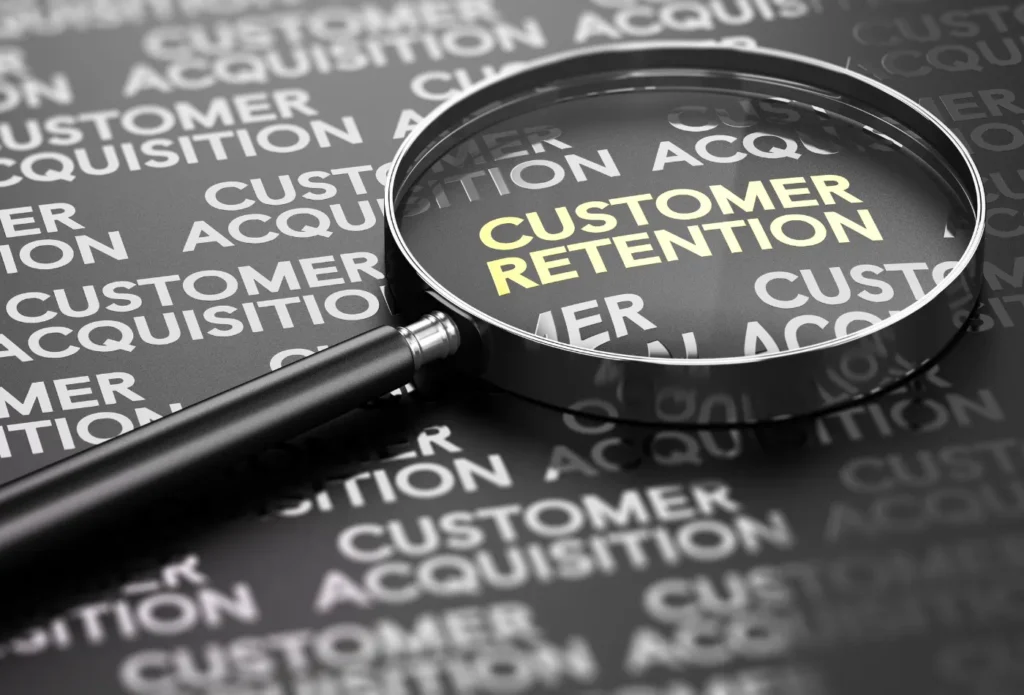The business landscape is a sea of constant change. Mergers, acquisitions, rebranding initiatives, and leadership shifts – these transitions, while necessary for growth and adaptation, can create choppy waters for customer relationships. Loyalty can wane, trust can erode, and churn can rise if businesses fail to navigate these transitions effectively. Yet, retaining customers during such periods is crucial for maintaining revenue streams, safeguarding brand reputation, and ensuring long-term business success.
This comprehensive guide dives deep into the strategies that empower businesses to weather the storm of change and emerge with customer loyalty intact. By prioritizing clear communication, unwavering service quality, and a commitment to customer experience, businesses can not only retain their existing customer base but also foster deeper connections that lead to long-term brand advocacy.
Building Bridges of Transparency: The Power of Proactive Communication (Section 1)
Communication is the lifeblood of any healthy relationship, and this holds true especially during business transitions. Customers crave clarity and reassurance, and proactive communication serves as the bridge that fosters trust and minimizes disruption. Here’s how to establish effective communication channels:
- Early and Consistent Announcements: Don’t wait until the last minute to inform customers about upcoming changes. Issue timely notifications via email newsletters, social media updates, website announcements, and even personalized messages. Provide clear timelines and a roadmap for the transition, managing customer expectations and fostering a sense of control.
- Embrace Multiple Channels: A multi-channel approach ensures your message reaches the widest audience. Utilize email, social media platforms like Twitter and Facebook, interactive blogs, and even SMS notifications to disseminate updates and address customer concerns. Consistency across all channels reinforces brand messaging and builds trust.
- Prioritize Transparency: Be upfront and honest about the reasons behind the transition. Whether it’s a merger, a leadership change, or a rebranding effort, explain the rationale and the anticipated benefits for both the business and the customer. Transparency builds trust and demonstrates respect for customer intelligence.
- Open Dialogue and Addressing Concerns: Anticipate customer anxieties and proactively address them through FAQs, dedicated customer support channels, and open forums. Encourage questions and concerns, demonstrating empathy and attentiveness to customer feedback. This fosters a sense of partnership and strengthens relationships.
Anchoring Customer Loyalty: Maintaining Service Excellence (Section 2)
While communication sets the stage, it’s unwavering service quality that secures customer loyalty during a transition. Here’s how to ensure operational continuity and maintain service excellence:
- Invest in Staff Training: Equip your team with the knowledge and tools they need to navigate the transition smoothly. Training programs should address new processes, workflows, and any changes to customer service protocols. Empower staff to confidently answer customer queries and provide exceptional support.
- Minimize Service Disruptions: Streamline operational changes and implement strategies to minimize disruptions to customer service. Maintain established communication channels, response times, and service standards throughout the transition period. Prioritize a seamless customer experience.
- Conduct Quality Assurance Audits: Regular quality checks and customer satisfaction surveys are essential for identifying areas for improvement. Actively solicit feedback and address any issues promptly. This demonstrates responsiveness and a commitment to maintaining high standards during the transition.
Fostering Deeper Connections: The Power of Personalization (Section 3)
Generic communications might fall on deaf ears during a period of change. By personalizing interactions, businesses can create a sense of connection and demonstrate that they value each customer’s unique needs.
- Customer Segmentation: Analyze customer data to segment your audience based on demographics, purchasing behavior, and engagement patterns. This allows for targeted communication and the development of personalized experiences.
- Tailored Marketing and Loyalty Programs: Leverage customer segmentation to craft targeted marketing campaigns and loyalty programs. Offer promotions, discounts, or exclusive rewards based on individual preferences and purchase history. This incentivizes repeat purchases and reinforces brand loyalty.
- Personalized Communication: Go beyond generic emails. Use customer names, acknowledge purchasing habits, and personalize communications to foster a sense of value and appreciation. This builds deeper customer relationships that weather any transition.
Embracing the Omnichannel Experience: Engaging Customers on Their Terms (Section 4)
Today’s customers are active across multiple digital platforms. Businesses that want to retain their loyalty need to meet them where they are.
- Omnichannel Engagement: Utilize a diverse range of communication channels to reach customers effectively. Social media platforms provide real-time engagement, while email marketing is ideal for in-depth updates. Leverage SMS notifications for time-sensitive announcements and utilize chatbots to answer basic queries.
- Interactive Content Creation: Go beyond static announcements. Create engaging content such as blogs, video explainers, webinars, or even virtual events to educate customers about the transition, showcase new offerings, and address concerns in real-time.
- Embrace Social Listening: Utilize social media listening tools to monitor customer sentiment online. Identify emerging concerns and proactively address them through targeted communication or social media posts. This demonstrates responsiveness and a commitment to open dialogue.
Building a Feedback Loop: Prioritizing Customer Input (Section 5)
Customer feedback is a treasure trove of valuable insights during a business transition. By actively soliciting and acting upon it, businesses can refine strategies, improve processes, and ultimately enhance the overall customer experience.
- Multiple Feedback Mechanisms: Provide customers with diverse avenues to share their thoughts and concerns. Implement surveys, feedback forms, or create customer advisory boards to gather comprehensive feedback on the transition process.
- Data-Driven Analysis: Don’t just collect feedback; analyze it systematically. Identify recurring themes, prioritize actionable insights, and use them to refine your retention strategies. Demonstrate a commitment to continuous improvement based on customer input.
- Open Communication and Transparency: Once you’ve analyzed feedback, share key takeaways with your customer base. Acknowledge their concerns, explain how their input is shaping the transition process, and outline any changes being implemented based on their feedback. This transparency fosters trust and strengthens customer relationships.
Providing a Lifeline: Supporting Customers Through Change (Section 6)
Navigating change can be unsettling for customers. Businesses can ease the transition by offering clear guidance, resources, and ongoing support.
- Enhanced Customer Support: Emphasize customer support capabilities during the transition. Train teams to address inquiries related to new products, services, or policies resulting from the transition. Empower them to resolve issues promptly and provide exceptional support.
- Educational Resources: Develop educational content such as tutorials, FAQs, or video guides to equip customers with the knowledge and tools they need to adapt to changes seamlessly. Simplify complex information and make it readily accessible through your website, social media channels, or dedicated customer support platforms.
- Proactive Outreach: Don’t wait for customers to reach out with questions. Proactively identify potential areas of confusion and address them through targeted communication. Offer personalized support and guidance to customers who might be apprehensive about the transition.
Celebrating Milestones: Building a Spirit of Shared Success (Section 7)
Acknowledging milestones achieved during the transition journey reinforces customer loyalty and builds a sense of shared accomplishment.
- Customer Appreciation Initiatives: Host virtual or in-person appreciation events, exclusive product previews, or special offers as a token of gratitude for customer loyalty and support throughout the transition. Recognize loyal customers publicly and showcase their contributions to the brand’s success.
- Shared Success Stories: Highlight success stories of customers who have adapted to the changes and benefited from the transition. Share testimonials and positive experiences through social media campaigns or blog posts. This fosters trust and encourages other customers to embrace the new landscape.
Charting the Course: Measuring Success and Adapting Strategies (Section 8)
Customer retention is a continuous journey, and it’s crucial to monitor your progress and adapt your strategies accordingly. Here’s how to measure success:
- Key Performance Indicators (KPIs): Track key performance indicators (KPIs) such as customer retention rate, churn rate, Net Promoter Score (NPS), and customer lifetime value (CLV) to assess the effectiveness of your retention strategies.
- Customer Satisfaction Surveys: Regularly conduct customer satisfaction surveys to gauge customer sentiment and identify areas for improvement. Gather feedback on specific aspects of the transition, the new offerings, and the overall customer experience.
- Data-Driven Decision Making: Analyze customer data and feedback metrics to refine your strategies, optimize resource allocation, and prioritize initiatives that demonstrably improve customer retention during and after the transition.
Buy and Sell Online Businesses with Macbook Monster
Conclusion: Embracing Change with Confidence
Business transitions are inevitable, but the impact on customer relationships doesn’t have to be. By prioritizing clear communication, unwavering service quality, and a commitment to customer experience, businesses can not only retain their existing customer base but also foster deeper connections that lead to long-term brand advocacy.
Embrace change as an opportunity to strengthen customer relationships and emerge from the transition period with a more loyal and engaged customer base. Remember, prioritizing customer-centric approaches, actively adapting to evolving customer needs, and demonstrating a commitment to exceptional experiences throughout the journey are the cornerstones of navigating the currents of change and emerging with a thriving customer base. With these strategies as your compass, you can chart a course for customer retention success during any business transition.







